As I sit here
inside with all the windows wide open to the balmy spring air, the memories
are fading of the depth of winter cold, hauling up logs of wood to burn
in the fireplace that was lit most every day. Here, in mid-April,
the birds are chirping, the trees are full of fresh green leaves, the
flower boxes have already lost their daffodils and we are averaging temperatures
in the low 70s or mid to high 20s Centigrade. I've put away my
winter jackets and taken out the sandals and flip-flops. The weather
is so warm we have had a picnic or two recently. It is Spring after
all, and thankfully she acting her part.
What is more surprising
though is that we had this weather the first week of March! However,
March is a fickle month, and the 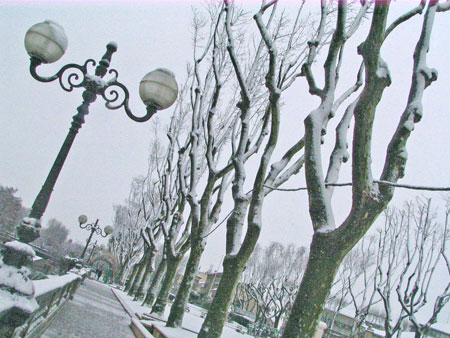 second
week of March brought us unprecedented SNOW! Not the light, melting
snowflakes to which we are accustomed in the South of France; the kind
that disappear on contact and light the sky up with lovely white twinkles. This
was a serious snowfall, so rare that the last time anyone could recall
such an enormous deluge in Narbonne was over 30 years ago! second
week of March brought us unprecedented SNOW! Not the light, melting
snowflakes to which we are accustomed in the South of France; the kind
that disappear on contact and light the sky up with lovely white twinkles. This
was a serious snowfall, so rare that the last time anyone could recall
such an enormous deluge in Narbonne was over 30 years ago!
It started on
the first Sunday of March. The initial warmth of the month quickly
disappeared into freezing temperatures. The sunny blue sky turned
a deep leaden grey, and big fat snowflakes started blanketing the town. Initially
they melted into the ground. But they kept coming and coming well
into nightfall. By the next morning there was about a foot – yes,
a foot – of snow covering the city. The quiet, white world
of snow was enhanced by the fact that Narbonne is mostly closed on Mondays. The
city prefers to have a lively Saturday and a snoozy Monday. Many
shops and restaurants are closed but banks and such are open. Thus,
the light foot and automobile traffic kept much of the snow pristine. So
it made for wonderful picture taking and walking.
Thus out came
the hat, gloves and overcoat, and with camera in hand I went to take
some pictures. Narbonnais children who had never made a snowball
were learning very quickly how to mash up a handful of snow and fire
away. There were impromptu snowmen here and there. But most
people just stayed indoors, so I was able to get some unusually deserted
winter scenes in the center of the city. The photos look black
and white, but are color; such was the tonality of the day.
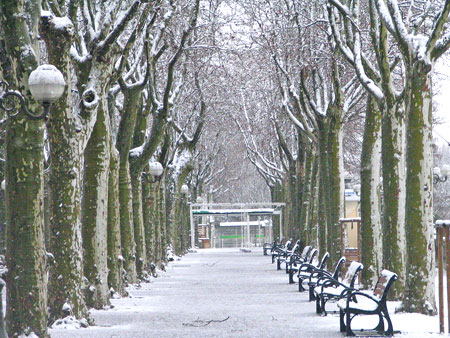 It stayed below freezing for
about four days, a very long time in this part of the French hexagon. So
we kept the fire going in the chimney and started to wonder about that
first week in March ~ would such weather come back soon we wondered. The
flower boxes that the city of Narbonne had already put out were not looking
too happy. Their blooms were crushed in the heavy snow and many
were lost to the cold. I was reminded of bigger, colder cities
when the snow turned to grey slush. Several patches became icy
and walking was hazardous. The charm of winter had definitely passed. It stayed below freezing for
about four days, a very long time in this part of the French hexagon. So
we kept the fire going in the chimney and started to wonder about that
first week in March ~ would such weather come back soon we wondered. The
flower boxes that the city of Narbonne had already put out were not looking
too happy. Their blooms were crushed in the heavy snow and many
were lost to the cold. I was reminded of bigger, colder cities
when the snow turned to grey slush. Several patches became icy
and walking was hazardous. The charm of winter had definitely passed.
Winter in Narbonne
is also the time for Carnivale. After the city takes down the ice
skating rink, the Christmas trees and the 40 log huts that were in the
place de la Mairie and the center of town for the month of December everyone
takes a breather in January. The weather is still not freezing;
the sky is often sunny and bright. It's a good time to take stock,
pull out the feather comforters, the fleece-lined slippers and recover
from the holidays. You have one month from January until Carnivale
which arrives the second week in February. Narbonne's carnivale
lasts about four days; this year's theme was The Circus.
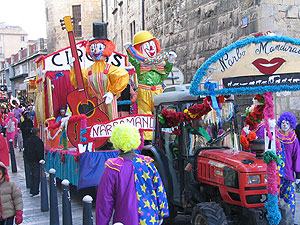 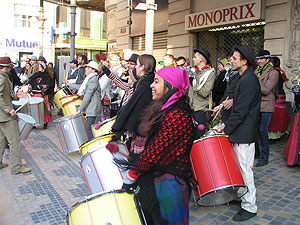
Although it didn't
snow in February, it is the coldest month of the year and can be very
windy as well. So Carnivale is truly a test for those who choose
to participate in their flimsy, colorful costumes or barely-there dancing
dresses. A long parade of stoic partiers circled the town on elaborate
floats flinging tiny silver stars into the air and on top of spectator
heads. There were shivering clowns, frozen dancing girls, trembling
trumpeters and trombone players and icy idlers with their hands shoved
deep into coat pockets. And the wind kept blowing. We all
stood around long enough to watch the grand finale: an enormous musical
playoff 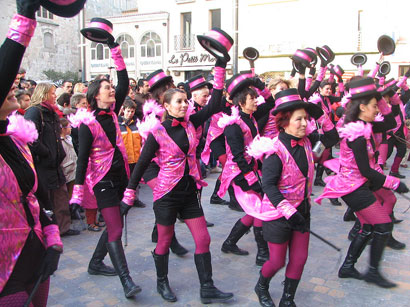 between a couple of dozen pink and black hot-pantied dancing girls and
several townspeople banging big bass drums. The drum-banging and
dancing was particularly energetic as all the participants were trying
to keep warm in the process. But as soon as it was over the crowds
evaporated into their warm abodes as did the carnival. My own fingers
were frozen from trying to keep them ready on the camera. Carnivale
in Brazil makes a lot more sense. I think four days of Carnivale
in a chilly February is plenty; however Limoux, a mountain town about
1 ½ hours from Narbonne, is famous for its three month long Carnivale. Brrrr. between a couple of dozen pink and black hot-pantied dancing girls and
several townspeople banging big bass drums. The drum-banging and
dancing was particularly energetic as all the participants were trying
to keep warm in the process. But as soon as it was over the crowds
evaporated into their warm abodes as did the carnival. My own fingers
were frozen from trying to keep them ready on the camera. Carnivale
in Brazil makes a lot more sense. I think four days of Carnivale
in a chilly February is plenty; however Limoux, a mountain town about
1 ½ hours from Narbonne, is famous for its three month long Carnivale. Brrrr.
So as I sit here,
enjoying this balmy spring weather, I take none of it for granted. Spring
is welcome and finally here to stay. Our local firewood provider
has seen us for the last time and probably won't be seeing us again until
the beginning of next year. As the seasons shift, so do we and
our lifestyle.
Early spring is
a good time to run around and see sights that the tourists will be clamoring
about in June. So we decide to head for the hills – the Pays
Cathare with all its incredible castles, churches and stories for which
the Languedoc-Roussillon is famous.
Catharism was
a name given to a Christian religious sects that appeared in the Languedoc
region of France and other parts of Europe in the 11th century and flourished
in the 12th and 13th centuries. There were various schools of thought
and practice amongst the Cathari as some were dualistic (believing in
a God of Good and a God of Evil), others Gnostic, some closer to orthodoxy.
Needless to say,
the Church was not altogether happy about this rising sect. There
were basic conflicts that existed between the Cathari and the Catholics
on both religious and material grounds. The Catholic Church thus
considered the Cathari dangerous and heretical. War was imminent. The
beginning of the 1200s saw the Church calling for a crusade. The
rest, as they say, is history.
Back to present
time, this history has left us with an array of incredible structures
built on lofty peaks of land scattered throughout the countryside of
the Languedoc. Many of them are easily reached within an hour or
two of Narbonne and make for a full day of hiking, and sightseeing. The
vistas are breathtaking from these peaks and you are guaranteed a day
of healthy exercise as well.
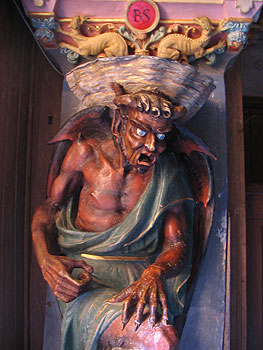
We started with
one of the most famous sites: Rennes-Le-Château. Situated
about one and a half hours inland from Narbonne, Rennes-Le-Château
is most sought after by tourists. Tens of thousands of tourists
visit yearly; many are interested in the site's role played in ‘The
DaVinci Code’.
Situated on the
top of one of the highest mountain peaks in the Aude region of the Languedoc
Roussillon, Rennes-Le-Château is a great starting point on the
Route de Cathares. It has a church which is still in operation
and the rectory is also kept in beautiful condition. The photos
show the colorful interior of the church complete with a very wild eyed
devil in the entrance. The holy water is perched on his head. The
inscription over the entrance reads ‘Terribilis’ which means ‘strong’ in
Latin. Visigoth symbols are mixed in with traditional Catholic
ones. The small cemetery has a cross which sits above the Latin
inscription: Quia Pulvis es et in Pulverem Reverteris - Ashes
to ashes, dust to dust. There are many other interesting details
which include a lovely small garden plus a lively village which has made
ample room for parking dozens of cars – testament to the surge
of tourism in the summertime.
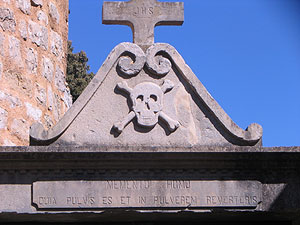 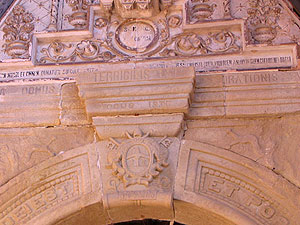
Ashes to Ashes Terribilis
Our next stop
is Château Villerouge, a well-restored Cathare fortress. We
learn here of the system of taxes or tithes which the Church used to
collect from the towns and villages. One tenth of the produce was
demanded, thus the word ‘tithe’ or ‘tenth’.
This collection
process was overseen by the Archbishop of Narbonne who reigned from the
Archbishop's Palace which is nestled next to the splendid Cathedral and
has an accompanying Donjon (dungeon). This is a structure which
is also known as a ‘keep’ in English and is defined as a
strong central tower. It is the most defended area of a castle
(the Archbishop's Palace) and may be used to store weapons, food and
even the water well. In the times of the Inquisition and the French
Revolution these structures would also ‘keep’ prisoners.
A visit to Narbonne's
Donjon is really a must. It is the oldest part of the Mayor's Place
(Place de la Mairie). It consists of five levels. The first
is dedicated to explaining the history of Narbonne in colorful tableaus. Then
a very narrow stairway takes you up the next four levels which have some
sculptures and stonework. Then you arrive at the open top where
steep steps climb to the very edge of the square peaks of the tower. Here
is the most magnificent view of the thousands of Narbonnais terra cotta
roofs, a dizzying view of the Via Domitia and the Canal de la Robine. The
Pyrénées Mountain range and the Mediterranean Sea are clearly
visible beyond the city limits. After enjoying the sights on the
outside of the donjon, a close inspection of the interior of the Donjon
shows neat and even elaborate carvings of the names and initials of some
of its former inhabitants. It is a chilly reminder of the past
several centuries.
Here in 2010 we
ponder on the age of this structure, built in the 1100s. Our apartment
is on the top floor of a ‘maison de maitre’ or ‘master’s
house’ built about 300 years ago. It has seen some history
as well. From our apartment we can see the Donjon and some of the
cathedral. But what we often remark on is not the donjon or the
cathedral. It is what circles these structures.
A flock of black
birds, similar to the California swallows of Capistrano which return
every year, circle the Cathedral in the morning and evening. They
swirl every day from early spring to late fall. Then they fly away
to warmer climates in the winter. They have just come back to Narbonne. At
first just a few came in the first week of April. Slowly more came
to join them. As they return they make loud calls as if to announce
their arrival to the city. They raucously dive by our windows in
wild celebration. They welcome the mornings with lusty calls to
the city. They then settle to a daily rhythm of circling the Donjon
and the Cathedral faithfully. Every morning and evening their calls
are accompanied by circling the ancient Narbonnais structures for an
hour each morning and night. Last year I wondered if they would
do this every day; now I know them and they are faithful - they only
dive by our windows on their arrival and then settle in for another season
of swirling the Archbishop's Palace and its Donjon. There are hundreds
of them, these small lively dark birds; I enjoy their perpetual motion
and wonder if they have been here for the last thousand years that the
palace has been here. Spring is back and so are they; they bring
comfort in their duration.
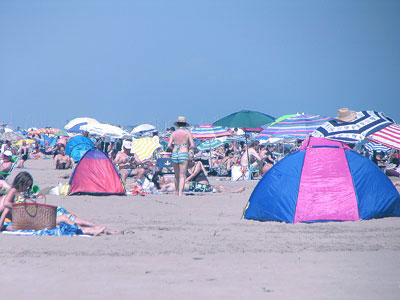
As we ease into
summer, here in the southwest of France, we have already begun our beach
life. The crowds have arrived earlier this year than last. The
end of May shows the beaches full and we are already contemplating where
we can find some spare sand in June. The springtime flower boxes
are gone, replaced by a surprisingly large amount of early tourists in
Narbonne. Some of the summer cafés have opened ahead of
time, perhaps stirred by the influx of travelers. We find new friends -
on the Canal du Midi and see old sailor friends who have wintered over
in their boats on the Canal de la Robine - depart for new destinations. Today,
La Fête des Mères is Mother's Day in France – Sunday,
May 30 - the last Sunday in May. The summer season promises
to be a busy one, and we are looking forward to it.
.....on to Summer |



